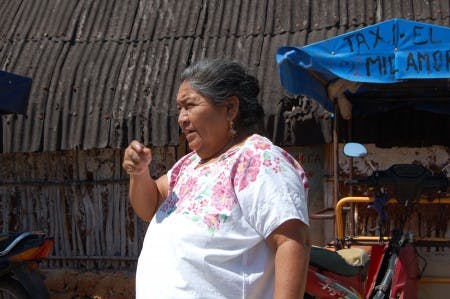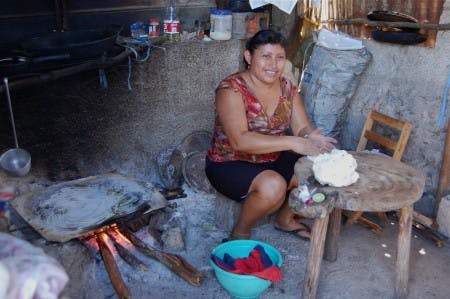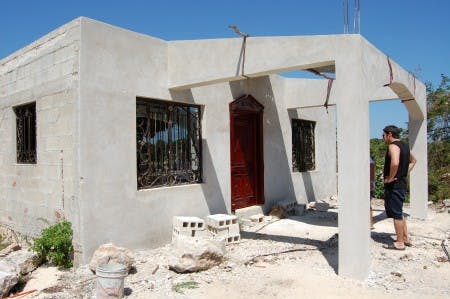In the Yucatán, there is no end to pretty Mexican villages straight out of your Hollywood imagination. There are low-slung rock walls enclosing thatched roofed houses with walls made simply of twiggy tree trunks. There are churches, the stucco faded by the sun. And old men wearing cowboy hats going by on bicycles, carting firewood on the back. And pickup trucks on the side of the road filled to the brim with nothing but watermelons for sale (and maybe a few paintings of Jesus and some plastic-wrapped pillows). On the not-so-Hollywood side of things, but equally essential to the Mexican vibe, every town, no matter how sleepy, has at least one speaker facing straight out to the street pumping out music at decibels so high that the sound is blown-out.
But if villages were to enter themsleves in a beauty competition, Tekit would win. This is the village that Juanito, one of our top line cooks and someone who has worked with Joe for five years, comes from. The guy who greets Joe every day with perfect English.
Yesterday we left Merida and headed towards Tekit, about an hour drive south on country roads. When we turned into the village, we couldn’t get over the bucolic scene of Juanito’s childhood. Gentle hills, nicely kempt, but typically modest homes, kids getting out of school in uniforms, the girls with white socks up to their knees. The village’s main industry is the making of guayabera shirts. In every other house we passed, you could see someone at a sewing machine and hear the sound of it chugging along.
When we arrived at Juanito’s house, which is comprised of four small rooms—half cement block, half thatched roof—his whole family was there. And by whole, I mean lots. A family where not one person speaks English. And I mean, not even “hello.” Needless to say, the day was a game of charades.
Juanito has never told Joe that he’s number 10 out of 12 kids. Well, we think tenth. It took his sister Paulina using both hands to count out the siblings to see where Juanito fits into the sequence.
At the house, his brother met us with a grin beneath his mustache, still wearing a hat with a veil on it and toting a canister of smoke, returning home from a day’s work with bees. Honey is something else Tekit is known for. His mother Lydia was there too and invited us into the house, past a dog lying flat in the sun to the point of looking dead (another staple of Mexico imagery), her puppies running around being skinny and cute. Inside, prominently displayed above the doorway, was a picture of Juanito and his brother Luis (who used to work at Tacolicious; Juanito’s brother Carlos still does). More family members were lounging around; a nephew was watching soccer on a small TV. One wall had a mounted deer head and a display of the rifle that shot it. To the right of it was a picture of Justin Bieber. There were no beds to be seen. It took a second for me to register that the hammocks tucked away on the walls were the beds.
His mother took us all the way into the backyard, where, amongst a bunch of very happy, free-range chickens, a couple goats (used both milk and barbacoa, she said with a smile), four squawking, hissing geese safely locked in a pen (why are geese such assholes?) her cocina was located—an open, thatched roofed, dirt-floored space with nothing but a comal, heated by a wood-fire, in the corner (though I did spot a refrigerator). Two of Juanito’s sisters sat around the fire, on preschool-sized chairs, making the tortillas for the day by hand. No press. Just patting out the masa with their hands, setting them on the flat, hot comal and letting them puff up for a second before they deflated and were thrown into a bucket lined with a dishtowel. As a food writer, this is the stuff that you only get to read about via someone like Rick Bayless. This is the stuff Carlos Petrini, the founder of the Slow Food movement, wets his pants over. But they weren’t doing it for us or for Carlos. They do this every day to feed their family.
His mother offered to make me something eat. She cracked an egg inside the tortilla and cooked it on the comal, handed me a huge plastic thing of salt and watched me eat her gordita with a smile, saying that Juanito grew up eating two of these every morning. Back in the car on the way to Tulum, Joe gave me grief about this moment because I was smiling so hard, having what he called my “Saveur magazine moment.” So shoot me.

The gordita with an egg. Simple and delicious.
Just like Noe’s story, this isn’t made up, and it gets even better. Paulina and Lydia walked us up to Juanito’s house, which is still under construction but mostly done. You heard me. Juanito, in his early twenties, has saved enough money by working in the US to have a house built for himself. With a modern kitchen that he will cook from (and will make Carlos Petrini weep with despair over the loss of the traditional comal), using the skills he’s acquired in the States where Mexican men cook. In Mexico itself, the day-to-day cooking is a woman’s job. My guess is that Juanito had never stepped foot in a cocina until he arrived to work for Joe as a dishwasher five years ago.
It doesn’t stop there, Juanito, from San Francisco, also has opened an internet cafe in Tekit (he sent us to Tekit to deliver an old laptop for it), as well as a small ranch—a ranch—land which his family works. It took going on this trip for us to realize that basically, Juanito, the guy that cooks at our restaurant, is a baller. And anyone who fears Mexicans moving to the United States to take over, or to do whatever horrible things Glen Beck preaches immigrants are doing to our country, I’m here to tell you, from first-hand experience, that Juanito—and Noe, for that matter—have only come to the US to make more than the $10 a day that they would make in Mexico. Their goal is to go home. And after seeing Tekit, I don’t blame Juanito.












